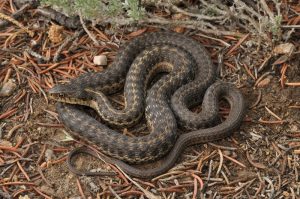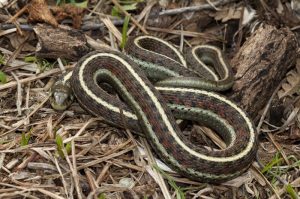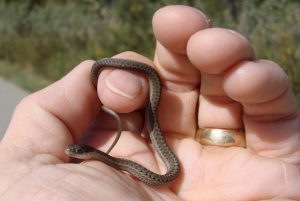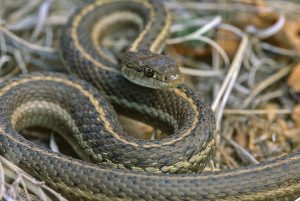Western Terrestrial Garter Snake
The medium-sized snake is basically terrestrial, but at times it becomes semi-aquatic. This is a North American snake that is venomous, but that is not detrimental for people. The venom can immobilize small preys only, that helps the snake swallow them. Unless extremely threatened, the snake doesn’t bite humans.
Scientific Classification
| Kingdom | Animalia |
| Phylum | Chordata |
| Class | Reptilia |
| Order | Squamata |
| Suborder | Serpentes |
| Family | Colubridae |
| Genus | Thamnophis |
| Scientific Name | Thamnophis elegans |
Quick Information
| Description | Size: 18.11-42.12 in (18.11-42.12 cm) Weight: Around 5.2 oz (150 gm) Color: The back is grayish-green while the belly is yellow, both sides have yellow stripes throughout the length, a few snakes might exhibit black spots on their back. Sexual Dimorphism: Yes; female snakes are larger than males |
| Distribution | Canada, North Mexico, and United States |
| Habitat | Mostly found in and around lakes and streams (slow flowing), but also common in mountainous areas, deserts, forests, and meadows |
| Subspecies | 1. Thamnophis elegans arizonae or Arizona Garter Snake 2. Thamnophis elegans hueyi or San-Pedro-Martir Garter Snake 3. Thamnophis elegans elegans or Mountain Garter Snake 4. Thamnophis elegans terrestris or Coast Garter Snake 5. Thamnophis elegans vascotanneri or Upper Basin Garter Snake 6. Thamnophis elegans vagrans or Wandering Garter Snake |
| Lifespan | Around 2 years in the wild and 6-12 in the captivity |
| Diet | Lizards, salamanders, slugs, fish, toad and frog larvae, and leeches, and small mammals |
| Adaptations | The snake has a foul-smelling secretion from its cloaca which it rubs off all over the body to ward off its predators. Their skin is capable of camouflaging against the surroundings through a cryptic coloration |
| Predators | Brewer’s blackbirds, ospreys, common crows, great blue herons, American mink, Virginia opossums, raccoons, American robins, bald eagles, ring-billed gulls, red tailed hawks, sandhill cranes, red tailed hawks, and northern harriers |
| IUCN Conservation Status | Least Concern |
Behavior
- In the morning, the snake warms itself up by basking in the Sun and then starts looking for preys. But if it’s too hot outside, then the snake prefers to stay inside a shelter.
- The snake uses the same hibernation spot every year.
Mating and Reproduction
Female snakes use pheromone to communicate with male snakes for mating. Their common breeding season is spring but they mate in the falls as well. When the temperature starts to rise they mate and females leave the den or the mating spot soon after and males stay back at the spot to continue mating with other female snakes. The eggs are hatched inside the female snake’s body and 8-12 live young ones are born.
Life-cycle
Right from the birth, the young western garter snakes are on their own and there is no parental care involved. They start looking for food and often become aggressive in order to survive. Both male and female snakes attain sexual maturity around the age of 1.5 years.
Interesting Fact
- The snake species also has melanistic variations.
References
- https://animaldiversity.org/accounts/Thamnophis_elegans/#reproduction
- https://digitalatlas.cose.isu.edu/bio/reptile/serp/thel/thelfram.htm
- https://www.inaturalist.org/taxa/28398-Thamnophis-elegans
- https://bcreptilesandamphibians.trubox.ca/western-terrestrial-garter-snake/
Published on June 7th 2019 by Sahana Kanjilal under Coniferous Forest Animals.
Article was last reviewed on 5th December 2024.







